Kelly Spall & Ethan Lingenhol
Things To Do
Cunard Building/ U.S. Post Post Office
Built as a ticket office for the Cunard Passenger Ship Line, the grand interior of the Great Hall has murals on shipping themes. The Great Hall was converted into a branch of the U.S. Postal Service in 1977. The post office has recently been shut down, but if you peek through the center glass door, you can just get a glimpse of one of the murals. In addition, there are dolphin decorations on the outside. Broadway is going to split here, and you will likely see a gathering of people around the 7,000 pound "Charging Bull" statue at the fork. Stay to the left and you will come to 26 Broadway, the old Standard Oil Building.
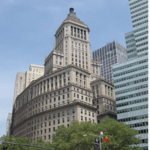
Old Standard Oil Building
Until 1956, this was the Standard Oil Building. In 1913, Upton Sinclair, the socialist novelist, led a demonstration here protesting the Ludlow massacre. Cross Broadway and you will find the next 2 stops, Bowling Green, and the old US. Customs Building.
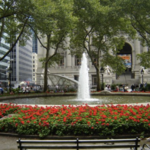
Bowling Green
This spot had been part of the Dutch cattle market from 1638-1647, then a parade ground, then a quasi-public green in 1732. The fence was erected in 1771, and the crowns knocked off by patriots during the Revolution. Also a statue of King George was pulled down and melted to use as bullets to shoot at the British, after the Declaration of Independence was read (up at the Commons) on July 9, 1776.
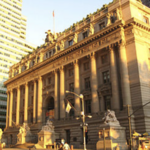
Alexander Hamilton U.S. Custom House
Built 1907, it sits on the site of the original Fort Amsterdam (which became Fort George, and was demolished in 1790). It was replaced by Government House where George Washington was to live, and then John Jay did as Governor. When the exterior was completed in 1906, the massive structure attracted attention as much for its statuary as its monumental scale. Daniel Chester French produced four great statues on the ground level based on groups similarly intent on situating the U.S. (and New York) in the global (and racial) scheme of things. It has now become the National Museum of the American Indian, appropriately enough, as local Indians were using the site when the Dutch arrived. Admission is free so if you're there when the museum is open, take a peek inside. Cross Broadway and head through the park to Castle Garden, also known as Castle Clinton. This is also where the ferries heading to Ellis Island and the Statue of Liberty leave from.
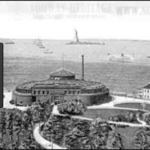
Castle Gardens
When it was constructed in 1807-1811, it was 300 feet offshore, and served (with Castle Williams on Governor's Island) as a defense fort during the War of 1812. Then it became a reception station for distinguished visitors (like General Lafayette). Then it became a concert hall named Castle Garden (1823-55). Then (1855-1890) it became the Immigrant Landing Depot where 7.7 million new Americans were processed. Then it served as the New York Aquarium until 1941 when it was demolished by Robert Moses. Now it sells tickets for the boats that go to the Statue of Liberty. It is open every day until 8, so take a look inside (THERE IS ALSO A PUBLIC RESTROOM HERE). There's an exhibit area that has three dioramas showing the site at various times. Next, go out the southern harbor-side door and walk to the water to see out in the distance what replaced it as the immigrant arrival center.
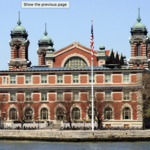
Ellis Island
1, 285, 239 people passed through here in 1907 alone. It has now been restored and a splendid museum opened. You can, if you wish, visit it; boat tickets are sold inside Castle Garden. After Castle Garden, walk in the direction of the Staten Island Ferry terminal, there will be signs or ask someone if you get lost. Aim for the big curving glass skyscraper, as your target is State Street. Look for the little red brick building with white columns next to it, at the point where State Street curves around and heads east. That's our next stop.
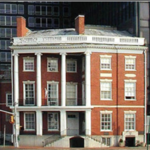
Shrine of St. Elizabeth Seton
The facade is the original 1793-1806 Federal mansion, the only survivor of a row of them. In 1801-03 Seton lived at No. 8 and founded the first order of nuns in the U.S. In 1883, No. 7 was the Our Lady of the Rosary mission aimed at young Irish women arriving at Castle Garden. To continue on the tour follow State Street to Whitehall Street, where you will make a left. Proceed to Pearl Street, make a right, and continue to Broad Street where you will find Fraunces Tavern.
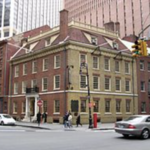
Fraunces Tavern
First, recall that Broad Street replaced the old Dutch canal that used to come up Broad to what's now Exchange Place. That's why the street is so broad. Pearl Street used to be the seashore, with glistening shells on its bank. Now tum your attention to Fraunces Tavern. This is not the original, which did occupy the plot. It is a guesstimate of what it looked like. There is a museum upstairs that is open from noon to 5 on Monday - Saturday. Admission is $4. Now when you come out, walk a little farther up Pearl Street, and you’ll come to No. 62, which is a real old building from 1827.
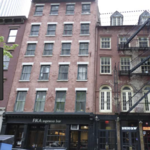
Corner of Pearl and Coenties Slip
Continue to the end of the block and look down to your right at Coenties Slip, noting the wedge shape of the street: it used to be an inset dock where ships tied up. Now walk across Pearl Street toward the golden marker. This marks the spot where a few years ago, during excavation for the huge office building in front of you, workers found the remains of the Dutch Stadt Huys, seat of colonial government, and also an old tavern and well. Colonial governor William Kieft built the Stadt Huys, or City Hall, in 1641 because he was tired of entertaining visitors at his home and wanted an inn to send them to. Twelve years later, it became the first city hall of New York. This tavern served as New York's second city hall, from 1670 to 1706, when in burned down. Walk left up Coenties Alley, and make a right on Stone Street. With lots of outdoor tables set up by local restaurants, pass the Mill Lane on the left, this was the site of the first Jewish Synagogue in the city, Shearith Israel.